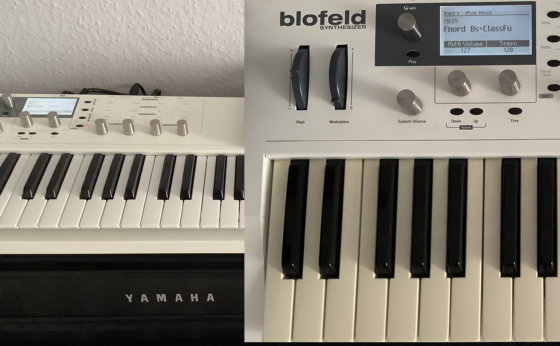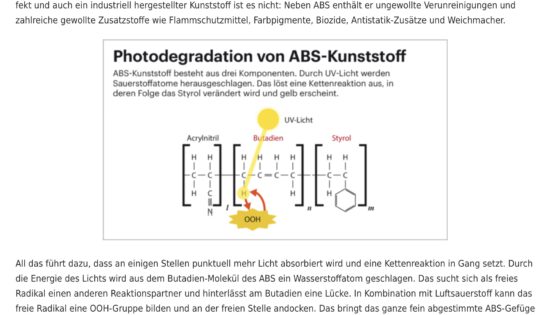
A short Christmas meditation on yellowed keys and plastics, with some empirically sound facts at last, and with a slightly tainted good message.
When it’s Christmas, it’s time to clear away the analog synths to make room for the tree in the living room – the kids insist on it. At least there is room enough to get the Blofeld from the storage. O joy! It feels like building the model train course again.
One thing I really enjoy: My Blofeld has wonderfully white keys again – I spent good money on a replacement keyboard in spring as the old keyboard had turned to a really nasty yellow tint, and I just could not strand it. As my previous attempt at brightening old keys had been a rather big effort and not really that satisfactory, I had decided that it was worth the money – and the friendly Waldorf support helped me get a new FATAR keyboard in an instant.
But why do keys turn yellow after all, and what can you do about it? In my small Jenny adventure, I had developed the theory that flame-repelling chemicals from softbags may play a part in it – as the Blo was well as my heavily yellowed R3 had been stored away in a dark, dry and warm place for months in softbags. But as chemistry is not my strong side, I am glad somebody has explored the issue at last.
The German computer magazin c’t had a retro issue this year with all kinds of wonderfully nostalgic explorations into old technology, but also a deep dive by Jan Mahn into the chemistry and science of yellowed and brightened plastics. (You can buy a copy of the magazine here, but it’s in German only.)
It’s the light, Stupid!
First insight is that my theory on the softbags seems to be bollocks. It’s really just the light, even if the effects take some time to show – in the case of my R3 and Blofeld, I must admit that they have been sitting in a very sunlit corner for quite some time, although it showed only months later.

The energy of UV lights strikes hydrogen atoms from the butadiene molecules, triggering a chain reaction… as if I knew what that means, but the science seems to be sound, especially as Jan Mahn talked to some guys with the expertise to back it up – curators from a technology museums who have solid experience and empirical knowledge of keeping old plastics bright.
They also experimented with bleaching solutions, based on hydrogen peroxide and, once again, lots of light energy – you might want to try the Retr0bright gel which is easier to handle, more on this in the Jenny article – and they found that it really works well…
…but there is a catch. The bleaching process alters the substance, not in a way that lets you feel or see it, but one effect of the bleaching is that the plastic will yellow again very fast. And being somebody who used to bleach his hair for years, I can testify that you can only repeat the bleaching process so many times before it causes damage.
TL;DR: Bleaching works – but it won’t work forever. You may have to live with a certain degree of tint. And keeping your beloved keyboards from the sun really helps.
Verwandte Artikel:
- Whitening Jenny’s smile: Bleaching old synth keys (Saturday, 30. July 2016; Schlagworte: bleaching, chemistry, hydrogen peroxide, Jen SX-1000, Keyboard, old plastic, oxygen, plastic, Tastaturwäsche)
- Fixing a Waldorf Blofeld’s jumpy encoders (Sunday, 24. January 2016; Schlagworte: auseinandernehmen, dismount, DIY, Drehknöpfe, fix encoders, Synthesizer, Waldorf Blofeld)
- Did you know that those rotary switches from Minimoog and Co. can be configured? (Sunday, 11. December 2022; Schlagworte: Basteln, DIY, Synthesizer)